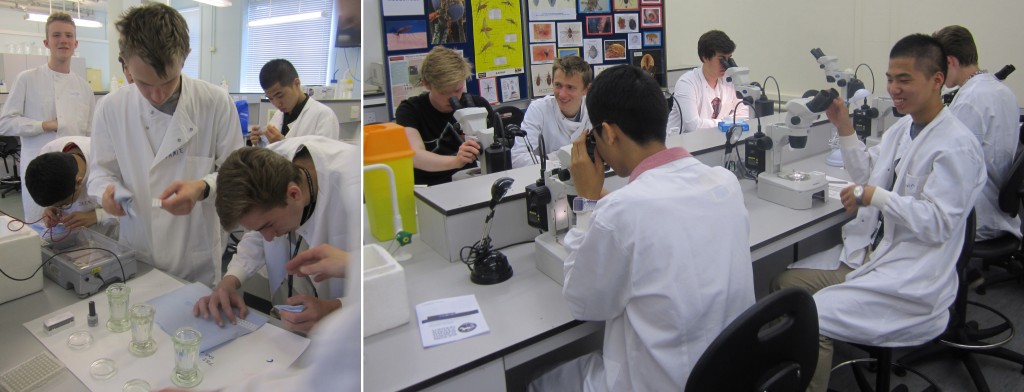On 25th and 26th June, Matt Rogers and I hosted a group of seven year 12 students from Dulwich College at LSHTM for an intense two days of lab work, talks and tours – ‘from molecules to cells to insects’. The idea was to give them a taste of what scientific research is like and to show them the application of some of the techniques they’ve been studying at A-level.
The boys and their two teachers arrived at 10:00 on the first day, and after being equipped with lab coats and given the essential health & safety talk, they got straight down to learning a little bit about parasites; in particular, the kinetoplastid parasites (Trypanosoma brucei, T. cruzi and Leishmania) and the devastating diseases they cause – African sleeping sickness, Chagas disease, and the various forms of leishmaniasis.
They had an opportunity to run their own experiments, using some of the techniques that are helping us to understand how the current drugs work and how drug resistance can evolve. These included DNA analysis using PCR and agarose gel electrophoresis, and protein localisation by immunofluorescence. The latter culminated on day two with a visit to the imaging suite to use the epifluorescence microscope to see the sub-cellular localisation of two trypanosome proteins involved in drug uptake.
The rest of day two was spent working on a different scale, looking at the insects that spread many medically important parasites. After Matt described the role of the sandflies in transmitting leishmaniasis, the boys had a go at the fiddly task of dissecting a sandly, an insect that is considerably less than 1 cm long! This is an essential skill that, along with a battery of molecular approaches, has enabled Matt and his colleagues to develop our understanding of the sandfly-Leishmania relationship.
Inevitably, given the lab work that we’d planned, there were lots of gaps in the schedule to allow for all the necessary incubations. On day one, these were filled by tours of the DNA sequencing and high-throughput drug screening facilities, and a talk on malaria vaccines. Day two included an impromptu demonstration of the confocal microscope in the imaging suite, a talk on the use of animals in research, and a tour of the insectories. Day two finished with a talk (and demonstration!) explaining why mosquitoes find some of us so attractive, and another looking at cutting edge approaches to controlling mosquito-borne diseases. A big thank you to all our colleagues who volunteered (with surprisingly little arm twisting!) to share their expertise and enthusiasm with the boys. Thanks to Ozan Gundogdu, Ross Pavely, Kevin Tetteh, Annie Tremp, Patricia Aiyenuro, Hollie Burrell-Saward, Nina Stanczyk and Tom Walker for all their contributions! Thanks also to Cheryl Whitehorn, Victoria Miari and Emma Cobb for letting us use your teaching labs!
Considering this was the first time that Matt and I had run a programme like this, it was remarkably sucessful, which was underlined by the feedback that we received from the boys…
‘the experience opened my eyes to the breadth and depth of research going on, which was underlined by the variety of lectures and practicals we had‘ – Jamie
‘The lecture on [the] use of animals in parasite research gave me a deeper insight on the laws and regulation of animal research in the UK‘ – Jack
‘seeing things such as the new DNA sequencing machines along with talks on the newest malarial vaccines gave us an insight into the cutting edge of the field‘ – George
With a few tweaks here and there (and hopefully with the continuing support of at least a few of our esteemed colleagues?!), we might just repeat it next year!
